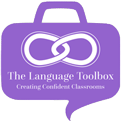
Twice as Nice!
School
Date
Language Program
St Michael’s Grammar School, St Kilda, Victoria, Australia.
September 2016
French and Japanese
When you meet a great teacher, you just know. They live and breathe school life and are always thinking of new ways to enrich their programs. They seek to provide the very best learning opportunities in which ‘their kids’ can achieve success. Great teachers are caring, organised and dedicated and they understand what it means to make learning fun.
They’re inspirational teachers, the ones who encourage their students to believe that anything is possible. Because it is.
When these great teachers are also language specialist teachers, pure magic occurs and their impact is felt throughout the whole school. I recently had the honour of visiting such a school – St Michael’s Grammar School, which is located in the inner Melbourne suburb of St Kilda.
To say that I was impressed with their Languages program is an understatement!
Prior to my arrival at St Michael’s, I wasn’t sure at all what to expect – this was my first visit to a school that explicitly taught students in Prep to Year Six not one, but two additional languages: Japanese and French (Yes, I could hear the potential concerns from new parents – “But don’t they get confused with two additional language programs?”
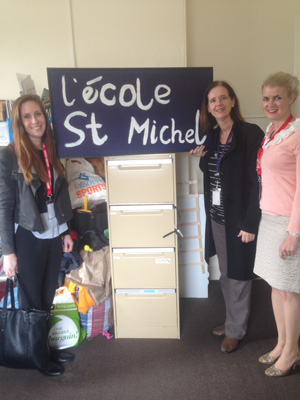
Pictured is Yours Truly with visiting teacher Caitlin (LHS) and Madame Huntington.
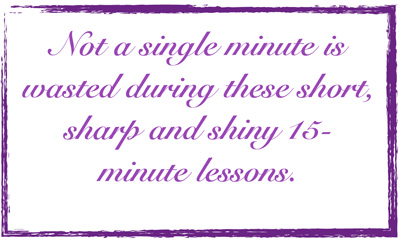
This isn’t the case at all – I will explain why shortly). There are two (main) specialist Languages teachers for the junior classes, and my hostess for the day was the very lovely, truly inspirational French Teacher Madame Huntington. She’s been teaching French to students for some time and clearly loves every minute! She exudes passion for additional language-learning and instills a strong sense of enthusiasm amongst her students. This became very clear to me, even before the morning bell chimed – the children’s smiling faces as Madame Huntington greeted each of them in French told me so.
Both the Japanese and French curriculum are taught using the AIM teaching methodology. AIM – Accelerative Integrated Method – is ‘a unique, multi-faceted program which uses gestures (a specifically researched ‘pared down’ language) with stories and music to rapidly develop students’ fluency. Source: http://www.aimanz.com/what-is-the-aim/.
The gestures correspond to specific words or concepts and are taught to the students so that they can communicate using both the gesture and the new phrases. It is incredibly effective!
Another element to the success of the language programs at St Michael’s, is the frequency of explicit French and Japanese teaching. Students here attend more than one Languages class throughout the week.
The timetable is structured to allow for several 15-minute lessons to occur for students in Years 1, 2 and 3. These are often taught either at the beginning of the morning session or at the beginning of the afternoon session. As the students progress through the schooling years, additional 30-minute classes are incorporated for Years 4 to 6. Creating the timetable is, initially, a complicated process – as it is within any school. However once established, the timetable accommodates for all teaching hours and classes and the programs run smoothly and often simultaneously across the school.
My first round of observations commenced at exactly 8:45am. I was in a Year Two classroom and from the very beginning, the students are completely immersed in the French language.
Not a single minute is wasted during these short, sharp and shiny 15-minute lessons: all communication between the teacher and her students is in French. If they (the students) happen to commence a conversation in English, they are stopped and are instead encouraged to continue speaking only in French.
This particular lesson began with Madame Huntington asking the students how they were: “Ça va?” and questions about today’s weather: “Quel temps fait – il?”
The students responded confidently and in complete sentences. If they made a mistake, it was corrected and they simply continued on from their stumbling block – no big deal.
These seven year olds had bucket-loads more bravery than my adult language-learning peers! There’s no fear of failure in this classroom!
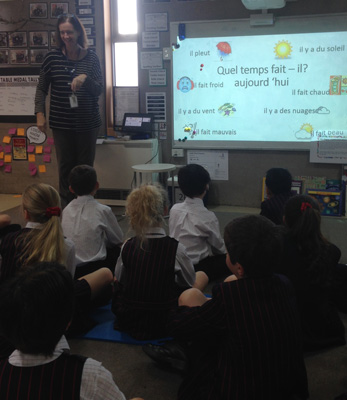
Madame Huntington ‘mid-gesture’ whilst teaching this Year Two class.
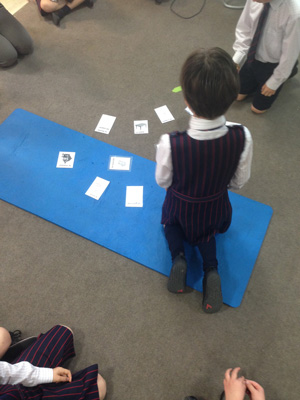
‘Fly-Swat Game’
The next activity was a quick game to encourage vocabulary development.
Students were asked to move into a circle and a set of cards containing new words and the associated picture, were placed in the middle.
Two students at a time were given a fly-swat and as Madame Huntington said the word/phrase with the accompanying gesture, students were required to race against each other to see who could locate and ‘swat’ the card first! A highly engaging game for all involved!
The ‘Fly-Swat Game’ was a stepping-stone for the next stage of the lesson. Students were then asked, all in French of course, to pack-up the cards and move back to the front of the room – it was time to read the Big Book.
This was an interactive task; the students read and responded to the text with their teacher – and they all knew exactly what was occurring with the characters in the story!
The conclusion of the story marked the conclusion of the lesson. I was shocked! Was it really the end? And did all of this actually occur in just fifteen minutes? Yes and yes!
These high engagement levels were replicated in each of the following classes I visited.
Smiles, laughter and active language learning was occurring before my very eyes – it was marvellous!
And because of this, because the learning was fun and connected with reality, the students were able to make strong learning links – for each language.
The positive effects of learning more than one language have been extensively documented. Multilinguals demonstrate increased attention levels, are more effective decision-makers and have an enhanced ability to recall information. The physiological benefits for learning multiple languages are also well-researched.
Learning another language has often been described as “mental gymnastics” for the brain which can delay the onset of dementia.
But these kids don’t need convincing; they already know that learning both French AND Japanese is good for them!
Happy students = happy learners!
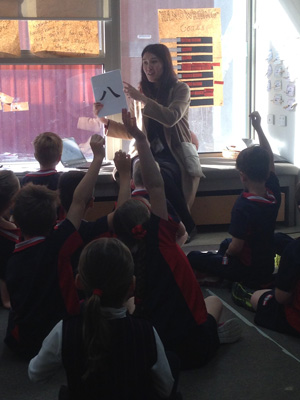
Year One Japanese Lesson.
And as for the other teaching staff ? Do they acknowledge the benefits for having such a rigorous and at times, complicated timetable? YES! A very generous classroom teacher gave-up some of her recess to share her thoughts with me;
“The two languages are very beneficial – they help to activate both sides of the students’ brain. I prefer the regular 15- minute lessons to the one-hour language classes at my old school – it’s like Bootcamping for language learning!”
Her next comment was music to my ears:
“I’ve never seen children enjoy languages so much!”
The Languages programs at St Michael’s are respected because the Languages teachers are respected. Moreso, the benefits for learning an additional language are understood and appreciated by everyone; students, staff and parents. It is a level playing field. And when you’re a Year One student who wants to purchase an actual ice-cream from the French Ice-Cream Store, you know that you have to learn how to ask for the flavour you want in French – which is exactly what these seven year olds did!
Well done St Michael’s – you are a Stella School!
By Tilka Brown
©The Language Toolbox
For more information about St Michael’s, please see their school website: https://www.stmichaels.vic.edu.au

